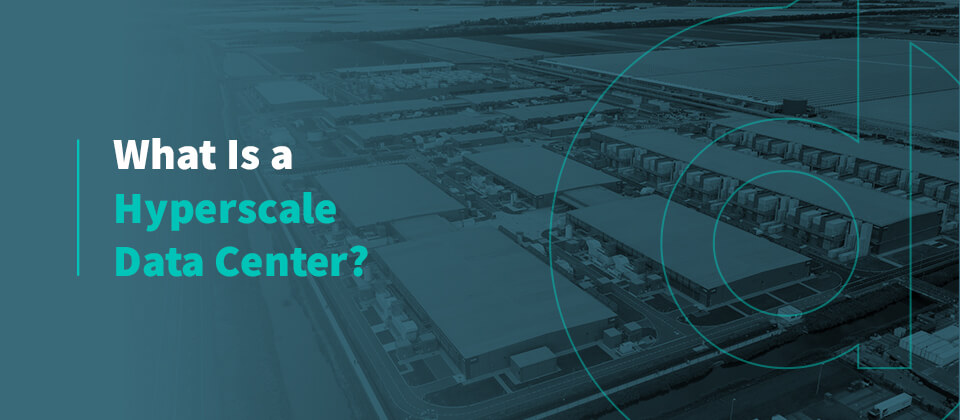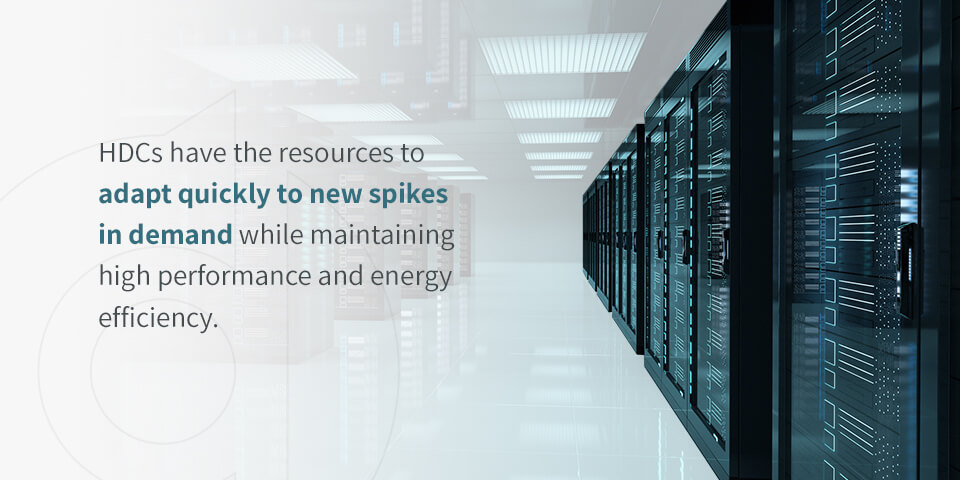
What Is a Hyperscale Data Center?
A data center houses and processes an organization’s most business-critical data. In the old days of data centers, large enterprise facilities were the top players in efficiency, security and cutting-edge equipment.
With the recent rise of hyperscale data centers (HDCs), however, the data center world is rapidly changing. According to current estimates, the number of HDCs in operation could grow to 1,200 worldwide by 2026. HDC market projections show significant growth from 2021 to 2026 at a compound annual growth rate (CAGR) of 3.38%.
Global hyperscalers are leading the industry in energy efficiency, technology innovations and computing performance. This post explains what makes a data center an HDC, how it differs from standard data centers and why this new type of facility is at the forefront of today’s IT landscape.
Hyperscale Data Center Defined
An HDC is a massive computing facility exceeding 5,000 servers and 10,000 square feet. Because they’re so large, their design is significantly different from most standard data centers. These facilities are built to facilitate easy, rapid deployment without reducing performance and efficiency.
The defining characteristic of HDCs is their ability to scale rapidly when demand changes. This agility goes beyond simply scaling up to meet growing demand — HDCs are also capable of quickly scaling down and “out” as needed. Scaling out is a horizontal approach to meeting client needs that involves adding more servers to the existing infrastructure. HDCs often scale out to minimize latency for their clients, which is known as edge computing.
Hyperscale Data Centers vs. Enterprise Data Centers
Although they may seem similar, HDCs differ from enterprise data centers in many ways. Some key differences include:
- Size: HDCs outsize enterprise data centers by several orders of magnitude. Due to their size, HDCs can take advantage of economies of scale to outperform typical enterprise centers in energy efficiency and processing output.
- Efficiency: For context, a power usage effectiveness (PUE) rating of 1.0 is a perfect score. Because HDCs can often leverage economies of scale and massive budgets, their PUE is significantly better than most enterprise centers, which average between 1.67 to 1.8. The most efficient HDCs can average scores of as low as 1.1.
- Technological innovations: HDCs are also typically more automated than enterprise facilities. Some HDCs are so tightly controlled and automated that they can “self-heal” or adjust to bring breaks and delays under control without human intervention.
- Standardization: Many HDCs develop their own standardized hardware and software to streamline scaling and improve flexibility. This equipment often trickles down into enterprise systems once it has been successfully implemented in HDCs. Some examples include secure modular servers, liquid cooling systems and virtualized software.
Hyperscale vs. Edge Computing
Edge computing involves processing data as close to its geographical origin as possible to minimize latency. Often, this involves moving some processing infrastructure out of the main data center and closer to the data source.
Instead of transmitting raw data to the central facility for processing and analysis, the localized infrastructure can perform the necessary operations where the data originates. Only the products of that analysis go on to the main data center for review and storage.

In contrast, HDCs are more general information hubs — like your standard central data center, but on a massive scale. HDCs have the resources to adapt quickly to new spikes in demand while maintaining high performance and energy efficiency.
By scaling out and placing servers in new availability zones, HDCs enable the rapid growth of edge computing. More specifically, hyperscale cloud providers are building more availability zones in near-edge or middle-edge locations, which enables application- and latency-specific deployments.
Who Owns Hyperscale Data Centers?
The most prominent hyperscale data center companies include today’s biggest names in tech. These companies have enormous data processing and storage needs beyond what the typical enterprise data center can meet.
Typically, companies that own HDCs generate revenue directly through the apps and products they sell.
Some of the most recognizable hyperscalers include:
- Microsoft
- IBM
- Amazon
- Alibaba Group
- Facebook/Meta
- Apple
Of these companies, U.S.-based tech companies own the largest proportion of hyperscale data centers worldwide. Often, if a company’s needs expand to hyperscale requirements, it will either build its own facility or lease infrastructure from data center development companies.
Where Did Hyperscale Data Centers Come From?
More companies are outsourcing their IT systems than ever, and demand for cloud storage and computing services has soared in recent years. One of the main drivers behind this spike in demand is the rapid growth of internet companies, the Internet of Things (IoT), 5G and AI deployments.
Hyperscale data centers arose to meet that need. With their ability to scale out beyond what standard data centers can do, they enable the growth of edge computing services closer to the origins of data.
Where Are Hyperscale Data Centers Located?
Most HDCs are located in Tier 1 markets — central locations that enable minimal latency. Here are some examples:
- United States: Chicago, Silicon Valley, Phoenix, Atlanta, New York City, Dallas
- Europe, the Middle East and Africa: Frankfurt, London, Amsterdam, Paris, Dublin, Madrid
- Asia-Pacific: Singapore, Sydney, Hong Kong, Greater Tokyo
However, if they can achieve strong connectivity and have a reliable energy source available, hyperscale data center companies can set up in rural areas. Examples include locations like Ohio and Oregon.
While exact specifications are hard to obtain, we can identify some of the largest hyperscale data centers worldwide. The world’s largest hyperscale data centers include:
- Inner Mongolian Information Hub: Owned by China Telecom, this facility is estimated to be around 10.7 million square feet in total area. However, it is unclear how much of this campus is used for data center operations. It is located in Hohhot, China.
- CITADEL Campus: This HDC is located in Reno, Nevada, and belongs to the international tech company Switch. Currently, at 1.3 million square feet, its full build is planned for 8.2 million square feet, which would make it the largest single-company data center in the world.
- Switch Las Vegas Core: At 2.7 million square feet, this data center seems much smaller than the others on this list. However, it is incredibly powerful and includes additional buildings under construction to bring the total to 4.2 million square feet.
- Facebook’s Prineville Campus: Facebook’s largest data center fills nine buildings for a total of 3.7 million square feet. This campus, located in Prineville, Oregon, is scheduled to open two more buildings in 2023, adding nearly another million square feet.
Contact DataSpan for Custom Data Center Services
As cloud services, edge computing and internet companies continue to grow, data centers will need increased capacity and efficiency to meet their client’s performance needs. HDCs have already mastered these concepts, but many smaller data centers must catch up to remain competitive.
If you’re considering scaling up, down or out, the experts at DataSpan can help you develop the solutions you need to reach your goals. Find your nearest rep here, or contact us for more information.








